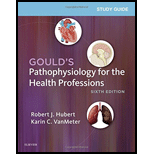
To list: The causes of pain.
Introduction: Pain is the feeling of discomfort that results from the stimulation of pain receptors in the body during the process of tissue damage. The body’s defense mechanism and the noticeable response to the problem are known as pain. Pain occurs due to various reasons. According to the reason of the pain, it may be described as short-term pain or sudden pain.
Explanation of Solution
Pain occurs due to various reasons. Depending on the causes of the pain, it may be referred to as short-term pain or sudden pain. The causes of the pains are listed below:
- Infections
- Ischemia
- Necrosis of tissue
- Tissue stretching
- Chemicals exposure
- Burning
In skeletal muscles, pain is caused by ischemia. Pain is also caused by the stretching of tendon, ligaments, and joint capsules. In the stomach and intestines, pain is caused by the irritation in the distention, mucosa, and ischemia.
Want to see more full solutions like this?
Chapter 4 Solutions
Study Guide for Gould's Pathophysiology for the Health Professions
- A 40-year-old male farmer was rushed to an ER with complaints of fever, abdominal pain/tenderness, nausea and vomiting. Clinical examination and investigations revealed diagnosis of typhoid perforation and he was booked for exploratory laparotomy. Explain in detail the pre - operative care of this patient.arrow_forwardAs a nursing student wanting to do preceptorship at ICU or ER, answer the following question: Why are you requesting this site? How will this unit meet your learning needs?How will this unit contribute to your professional goals?arrow_forwardAs a nursing student wanting to do preceptorship at the cancer clinic. Answer the following question. Why are you requesting this unit? How will this site meet your learning needs? How will this unit contribute to your professional goals?arrow_forward
- The importance of monitoring resident's wound healing (bed sores, cuts, and scrapes, etc.) and how can a nutritionist utilize this in their career? Please not just a short explanation.arrow_forwardThe importance of seeing how it is to work as a chief in a nursing home and how they accommodate for special diets (low sodium, low sugar, heart healthy, etc.) and how can a nutritionist utilize this in their career? Please not just a short explanation.arrow_forwardThe importance of dealing with work confrontation (different healthcare departments fighting; diet aide and CNA) as a manager of a kitchen and how can a nutritionist utilize this in their career? Please not just a short explanation.arrow_forward
 Phlebotomy EssentialsNursingISBN:9781451194524Author:Ruth McCall, Cathee M. Tankersley MT(ASCP)Publisher:JONES+BARTLETT PUBLISHERS, INC.
Phlebotomy EssentialsNursingISBN:9781451194524Author:Ruth McCall, Cathee M. Tankersley MT(ASCP)Publisher:JONES+BARTLETT PUBLISHERS, INC. Gould's Pathophysiology for the Health Profession...NursingISBN:9780323414425Author:Robert J Hubert BSPublisher:Saunders
Gould's Pathophysiology for the Health Profession...NursingISBN:9780323414425Author:Robert J Hubert BSPublisher:Saunders Fundamentals Of NursingNursingISBN:9781496362179Author:Taylor, Carol (carol R.), LYNN, Pamela (pamela Barbara), Bartlett, Jennifer L.Publisher:Wolters Kluwer,
Fundamentals Of NursingNursingISBN:9781496362179Author:Taylor, Carol (carol R.), LYNN, Pamela (pamela Barbara), Bartlett, Jennifer L.Publisher:Wolters Kluwer, Fundamentals of Nursing, 9eNursingISBN:9780323327404Author:Patricia A. Potter RN MSN PhD FAAN, Anne Griffin Perry RN EdD FAAN, Patricia Stockert RN BSN MS PhD, Amy Hall RN BSN MS PhD CNEPublisher:Elsevier Science
Fundamentals of Nursing, 9eNursingISBN:9780323327404Author:Patricia A. Potter RN MSN PhD FAAN, Anne Griffin Perry RN EdD FAAN, Patricia Stockert RN BSN MS PhD, Amy Hall RN BSN MS PhD CNEPublisher:Elsevier Science Study Guide for Gould's Pathophysiology for the H...NursingISBN:9780323414142Author:Hubert BS, Robert J; VanMeter PhD, Karin C.Publisher:Saunders
Study Guide for Gould's Pathophysiology for the H...NursingISBN:9780323414142Author:Hubert BS, Robert J; VanMeter PhD, Karin C.Publisher:Saunders Issues and Ethics in the Helping Professions (Min...NursingISBN:9781337406291Author:Gerald Corey, Marianne Schneider Corey, Cindy CoreyPublisher:Cengage Learning
Issues and Ethics in the Helping Professions (Min...NursingISBN:9781337406291Author:Gerald Corey, Marianne Schneider Corey, Cindy CoreyPublisher:Cengage Learning





